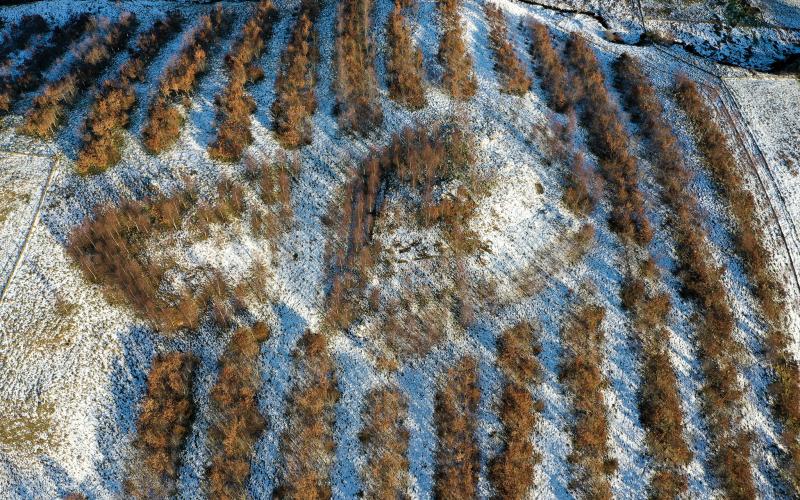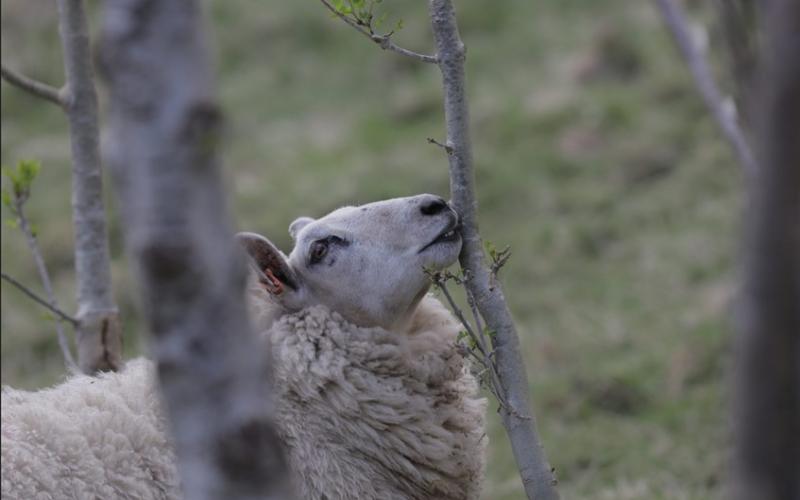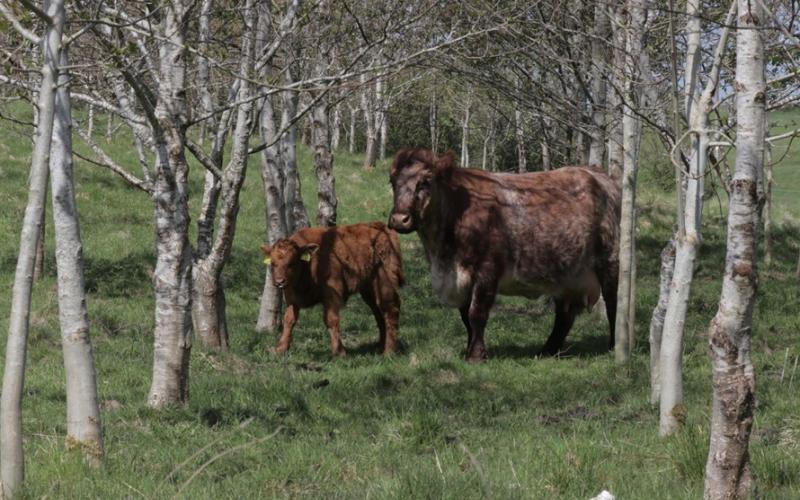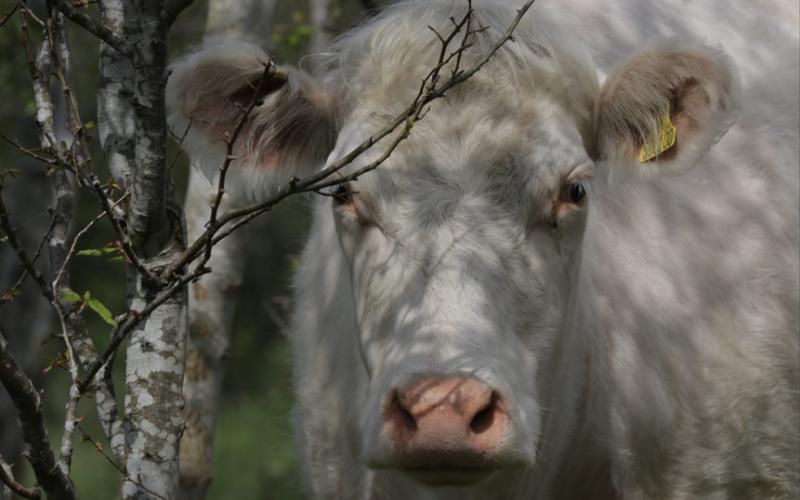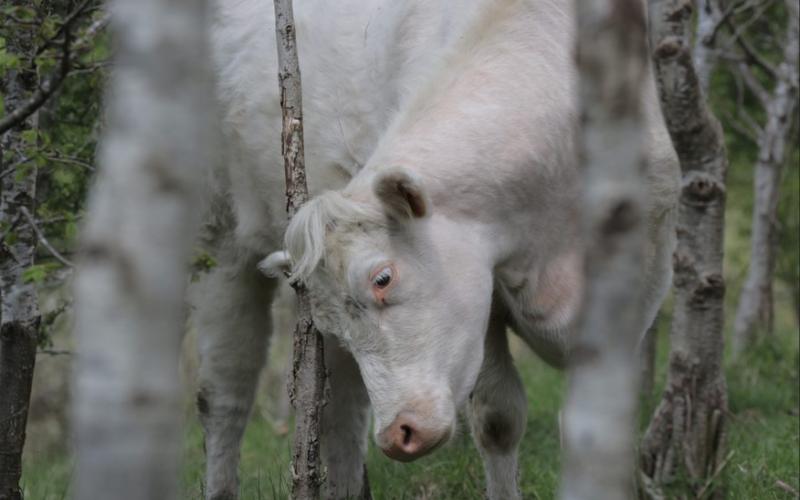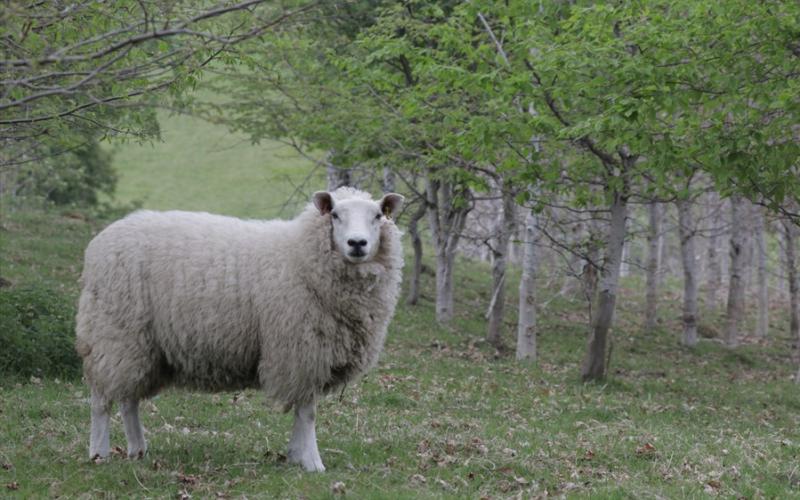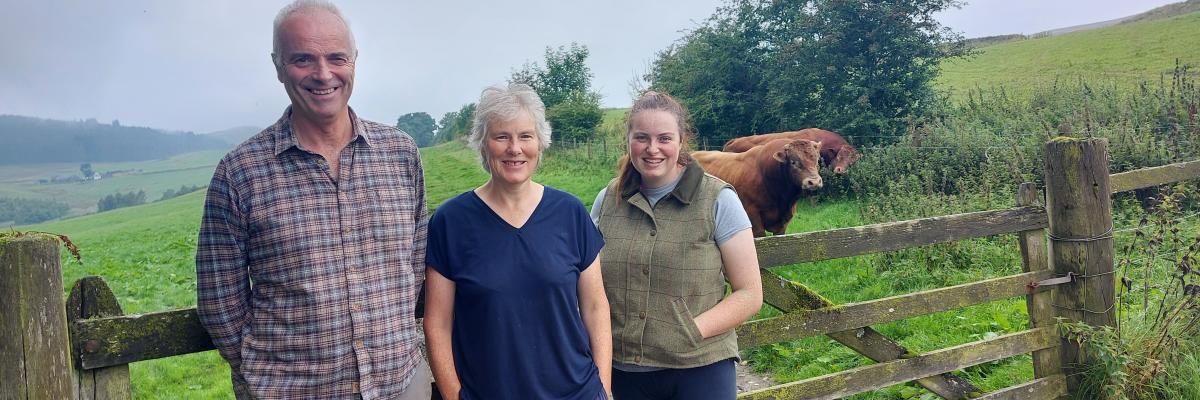
The Barbour family
FarmerMains of Fincastle Farm, Pitlochry, Perthshire
 We farm cattle and sheep on land that is part of the Bonskeid Estate, near Pitlochry in Scotland. Fincastle is 500 hectares (ha) of farmed land (plus a plantation of 40 ha), and since November 2021 we have taken on 300 ha of land at Borenich as well.
We farm cattle and sheep on land that is part of the Bonskeid Estate, near Pitlochry in Scotland. Fincastle is 500 hectares (ha) of farmed land (plus a plantation of 40 ha), and since November 2021 we have taken on 300 ha of land at Borenich as well.
It is very much a family business - Patrick is a biologist on the river Tweed, and Robert currently works for the Sustainable Food Trust in Bristol, but they help with sheep shearing, lambing, calving and hay time when they can. Catherine works full time on the farm alongside Seonag and myself (Andrew). Her background is in animal health which is very useful, our emphasis on health is stronger now, and her enthusiasm and commitment gives us older generations motivation! Fincastle has always been farmed in-hand by my (Andrew’s) family.
After the Second World War, my uncle ran all the grounds (Fincastle, Borenich and Bonskeid) as a farming business until the late 1980s. His health gave up and he let out the farm in bits as there was no succession plan in place. I worked as a forester and in the fish business, and was away a lot of the time. I got married and came back to the farm, where Seonag and I took on one bit and ran sheep and cows on it in the early 90s. I gave up full time work in fish farming when I moved back home in 1990 but continued to work in the sector part-time until 2018 when I 'retired.' The main cattle facilities were let out but came back in hand early 2000. By the late 90s, the farm had gone from traditional stocking of 600 ewes and 100 cows to slightly more cows and 1,500 ewes. It was an unhappy place - sheep weren’t performing - there were too many, they were sick, there were worm resistance problems and a huge coccidiosis problem on the farm - we were constantly dosing sheep and cattle. The farm was also failing Natura health checks - it was overgrazed, and we were getting blue green algal blooms in the loch because of the amount of phosphate that had been poured on the hills (by my uncle).
We weren’t happy with being part of the problem and took a conscious decision to move towards a low input extensive system which made business and ecological sense. It took a long time to be able to enact it but the final bit of land came back in hand last November at Borenich. So we’ve been on a journey since 2000. The cattle have now not been drenched for 15 years, sheep get an annual drenching but no more than that.
We've cut sheep numbers and moved away from a Blackface sheep producing a store lamb to a white faced commercial sheep - Texel / Lleyn main blood lines. The sheep stock we’ve taken over at Borenich are Cheviot. We’ll probably do more with Cheviot as the maternal line and use Texel as the paternal sire. We’ve almost halved sheep numbers and now run about 700 sheep between the two places. By doing that and moving towards better quality lamb we are able to sell fat, we have improved our margins, so financially the sheep now perform much better, and we have sorted out the health problems and put in a clean grazing system…
We also went organic (starting conversion in 2006 and becoming certified in 2008) - partly driven by the need to maximise pillar 2 payments and due to having been on the wrong side of the 2004 MacSharry reforms where we were frozen out of the direct support system. We were cutting out nitrogen (N) by then anyway - becoming confident with incorporating clover in to swards. We use a direct seed drill where we can to maintain a living ground cover and a variety of plants in the sward which help give the stock a more balanced diet and are also great for biodiversity and carbon capture.
We cross Highland heiffers with a Whitebred Shorthorn bull to give our base cow. These cows are crossed with a Limousin producing 18-month-old store cattle. A key part of our system is rotational grazing. We’re not mob grazing - we don’t think it’s good for our cattle welfare - they don’t like being tightly confined and like to change their habitats etc.. Also, the cattle only graze the hill grasslands in the summer months (no sheep) so that the flowers have the chance to flower as part of the rotation. We have a day-to-day and an annual (6 monthly) rotation - with sheep on the high grasslands in the winter months, and cattle on the high grasslands in the summer months.
The hill ground is divided up into 6 big grazing blocks - we move the cattle around according to the state of the vegetation. Their behaviours are naturally of mob grazing but they move themselves - they have the choice - which we feel is incredibly important. In that context, we would like to have every grazing block of land with access to trees for the cattle. If you give them trees, they use them daily.
The sheep have to follow on - the farming system is really designed around the cattle. Sheep are doing a financial job, a worm control job and a grass management job for conservation grazing. We keep the sheep in-bye and do an alternate cut graze system - they are moved every 3 or 4 days, rotational grazing within parks, which keeps the lambs growing as fast as possible (they are rough grazed in late summer/autumn and again after tupping through to lambing). Some years we get all the lambs away fat, others we decide to sell as store, it depends on the trade. We select high fat index tups - we’re looking for animals that can carry and will put on fat on natural vegetation. At Borenich we don’t have the cattle to put on there yet, but we will move on to a rotational grazing system and reduce the sheep numbers and increase the cattle numbers. We are calving 54 cows this year (2022) but expect to be running about 70 cows with all the ground we have now.
We sell the cattle to an organic finisher not far from us - cattle fit in to their organic system (they have an organic field veg business). Those animals go on to Waitrose. Last year the yields varied. Our cattle have high fertility rates - we would normally be in the high 90s % of calving rates, and wean at 320 kg roughly, at 8-month-old. We sell either a weaned calf at 8-month-old or forward stores at 18-month-old (they go off the farm at 420 / 440 kg), but we keep a few through to fat at 28-30 months old for private customers. Last year, we got £260 per kg for the weaned calves. Our gross margin per cow (normally between £400-£500) varies from year to year as our inputs (mainly P and K fertiliser and lime) varies, which is driven by regular soil sampling. The gross margin for ewes is about £70 per ewe. We aim at 150-160% scanning for lambs. Our losses for outdoor lambing were at about 13% last year (2021). We aim for a 42 kg lamb - they go to McIntosh Donald at Portlethen Aberdeen (they have an organic line). We also sell fat lambs through the conventional market, and last year sold quite a lot of store lamb to an organic finisher in Aberdeenshire.
The limestone at Fincastle makes it botanically very rich, and unusually, the highest parts of the farm have the deepest soils. Both Fincastle and Borenich have a long history going back to Bronze Age when there were settlements, so they are also very rich in archeology. Fincastle in Gaelic means ‘the land of the castle’ (ring homesteads). We have the highest density of iron age forts in Scotland! Of the 500 ha block at Fincastle, about three quarters is designated high nature value (site of special scientific interest - SSSI). There is 120 ha of improved pasture - some of which is in a SSSI area. The SSSI is also a Natura site (Special Areas of Conservation). Some of the lower rough grazing where there is wood pasture isn’t in it, however some of the rarest plants are not in the SSSI at all.

The grazing animals are essential to maintain the habitats in good condition - they open up the swards. Where parts of the farm have inadvertently been excluded from the designated sites and had grazing removed due to the siting of fence lines, the botanical interest has dropped, they’ve become swamped with coarse vegetation. A limestone pavement area has entirely gone to dog mercury, and meadowsweet has totally dominated in one area of fen … whereas on the grazed land adjoining it there are incredibly diverse plant communities. If we got rid of the animals and wanted to keep the open ground habitats in good condition, we’d probably have to bring the same amount of animals back in.
The black grouse and heron population are monitored on the farm (there’s a heronry just behind the farm), we also do our own monitoring of deer impacts. SNH monitor the Natura part. We have monitored tree growth measurements - if only so we can make some claims about the growth rate and carbon.
Agroforestry
We have established woodland on the farm including shelter belts and woodland grazing in small blocks. My (Andrew’s) forbears planted trees... Most of Bonskeid was woodland in the 19th century. We have always run a regenerative model, using the regenerative abilities of the woods; using seed fall to restock, and designing felling areas to make sure we’re never too far from any seed source. This results in very diverse forest.
At Fincastle, about 7% is covered with trees, but we’re adding bits every year. Borenich is more complicated (and is not yet mapped) - of the hill ground (250 ha), 50 ha already has trees on it which can be managed on a wood pasture system - we expect to give half of it over to trees, adding 100 ha (if we can get support). When the 50 ha was originally planted in 1999 (with permission of the tenant), we weren’t thinking in terms of wood pasture, but more in terms of being able to graze animals round the outside of trees, so managing the open ground elements of conventional native woodland. We are now ready to put sheep or cattle in - our focus is now on woodlands you can graze animals through and designing them that way - and we have gone from more of a biodiversity interest to focusing on carbon, together with the big benefits of wood pasture giving animals shelter and providing early grass.

Layouts & crop species
We looked at a block of 50 ha of lower ground on the farm which was used for rough grazing (important for winter and spring) and already had about 12 ha of woodland on it (mostly semi natural birch woodland, juniper and willow and a couple of hectares of shelter belt pine), and we added 9 ha of deliberately designed wood pasture (with the aid of a grant). A bit under half was then wooded and designed - so there was no more than about 5 ha of woodland with open ground inbetween - that part of the design is very important.
The blocks in that 50 ha matrix have been designed to reflect the sheep behaviour, what the ground can cope with, and where the natural history interest is. Where the sheep like to rest is more open but with shelter round it - they don’t like dark woodland and are frightened of predators. We excluded stock for the first 5 years after planting then introduced sheep (we left them in a short time first to watch them and see what they do). With cattle, it’s about the time of year you put them in, the length of time you put them in, and what else there is for them to eat.
Within the blocks, we implemented an alley system with alternate rows of grass and trees planted at quite tight density with the aim of heavily thinning - equivalent of 3000 stems per ha to promote timber growth to give an overall density of 1600 trees per ha when the grass alleys are included.
We aim to produce a 3-4 m clean stems for log production, then open grow the trees so they grow as fast as possible and thin them to give a final crop density of about 70 trees per ha. We have started the process with a trial this spring - cutting the trees but not snedding them - so the leaves flush and help dry the trees out, and some leaves are eaten by stock. We’ll try pollarding some and will coppice some and cut to ground level (stock will probably kill the coppice). We will then use that timber in the autumn - we’re looking at chipping it and doing a trial perhaps using it as a compliment bedding in the sheds. We haven’t yet worked out how to manage the manure - we are wondering whether we can just field store the chips mixed with manure or do we need to compost?
The grass alleys are 6 m wide, the tree alleys 10 m wide. This was influenced by the grant scheme we used. If we were doing it again, we would tighten the tree alleys, widen the grass alleys, and have the distribution more 50:50 or 40:60. If we left the trees and didn’t thin, we’d still end up with a well stocked woodland. Our aim is to keep a 60% canopy cover, so thin to that. The model depends on being able to thin, which could be a weakness (note the protective layer of blackthorn in the picture below).
The tree species are mostly oak and rowan (for timber), alder, some birch.. some Norway maple, a bit of ash and hornbeam…. we focused on trees we could coppice or pollard on the basis that we weren’t expecting to grow quality timber the first time round. We thought we might have to coppice to get straight growth again, but it’s looking quite good. Some species should have been included that aren’t. We have planted some hazel and holly since, and some aspen has self-seeded…
We planted another 2-ha alley system with birch and rowan and used tree tubes and let the sheep wander underneath. It is in an area with bad whins (gorse) so we were trying also to see if trees would eventually shade out the whins - sheep didn’t spend much time there so it was low risk. This took us on to different model with a lower density / lower impact approach with smaller groups of trees - including species such as alder, white beam, birch…) and having tree tubes with hot wire around the edges to keep cattle off and let the sheep go round - we have to accept there is a bit of management time to straighten tubes and inevitably a few losses round the edges. We have used this approach for smaller areas around field margins done without grant aid. We have planted bits every year - using tubes and electric fence to keep cattle off - which are disastrous for tubes!
This is an example of a smaller more recently planted area, where we have used double electric fencing to make it deer and cattle proof. It is not grant aided or designated land. Trees are in rows of three to allow for getting round with a quad bike and for the cows to go inbetween. Our main aim here is top shelter as opposed to side shelter - top provides shelter from sun and rain, side provides it from the wind. Cows particularly benefit from top shelter. We planted alder and white beam here mainly with it being one of the wetter sites.
Tree functions
The trees are multifunctional on the farm from a practical productive point of view - the shade and shelter benefits they provide (in both hot and cold and wet weather) vary according to where they are. January / February is when shelter makes the biggest difference.
Spring grass is our limiting factor and one of the main things we set our stocking by; what grass is available in the time of peak nutritional demand for the animals (early May for sheep). We still get frost up to June so earlier grass growth is a huge benefit - tree shelter ensures it is easily advanced by several weeks (which of course translates in to pounds and pence). You see the benefit in checked lamb growth - that crucial period in the growth rate with lambs.
The most valuable block of trees from a sheep point of view is a 4 ha block on the top of a hill that sheep use as a shed in the wintertime (see above and below) - without it, we couldn’t have moved from a Blackface (hill breed) to a Texel - they wouldn’t have coped with the winter environment. So it has provided an animal welfare and financial benefit (with us able to produce more fat rather than store lambs). Trees are also a source of firewood for the house. This last winter we’ve entirely heated ourselves with timber from this bit of woodland.
The function of woods on the farm that animals graze through at the moment is to produce sawn timber for ourselves, and eventually we’re hoping that the hard woods will have enough volume for commercial sale while providing shelter for stock and an earlier grass crop under the trees. Traditional sized shelter belts are too small for many commercial management operations such as thinning, so creating large-scale wood pasture allows bigger wooded areas without losing all agricultural productivity from that area, thus, in theory, allowing commercial scale operations to happen.
Tree roots improve drainage and leaf litter improves biological activity in the soils. The carbon trees are capturing on the farm has allowed us to reduce our net emissions by about a third.
Observations of how livestock use the woodland
Unlike sheep, cattle behave like a woodland animal - it’s their natural way of being when they’re given that choice. They use trees daily - for shelter from the sun as well as rain and very much for itching.

While they spend more time grazing outside of them, they seem to like being in trees - perhaps it’s to do with the structural complexity the trees create? There are also leaves to eat if they can reach them, which are very much part of the cow’s diet. They love browsing leaves in the spring. They seem to favour ash and sycamore early on, oak (with high tannin content) becomes less palatable as the season goes on. They like hawthorn, rowan, willow… birch is middling… they eat alder but they’re less desired…

We’ve noticed that though a cow will stand and take a leaf or two, it then moves back to grass - it’s like reaching for a bit of sauce to go with whatever they’re eating! Sheep seem to enjoy eating leaves too. Bark stripping is not much of an issue - a bit of Norway spruce in wintertime, a bit on ash, and bird cherry seems to be highly desirable - but it doesn’t seem to die when bark is removed. The leaves of bird cherry are supposed to be poisonous if they are left to wilt.
We calve outside - we think it's important cows can go off and adapt their behaviours to suit their needs. We had 10 cows born late last year because of a problem with a bull - we had run out of feed so the cows had to go into the only bit where there was grass with trees - there is a block where there is 3 ha of open hill ground and 1 ha of trees and all the cows barr one calved in the trees, choosing that ground. We now calve in 2 fields with a tiny block of trees and scrap of woodland (see below) - cows quite often calve there (but not exclusively - other factors come in to play).
We have been able to see first hand how much the sheep use the trees in the winter through using night thermal vision equipment - they spend their grazing time in the open, but after hours, they’re all in the woods. They use the woodlands for shelter and grazing in the spring and summer. It was exceptionally hot last summer and every clipped sheep sheltered under the trees. Unclipped were out in the full sun. When we graze sheep amongst trees in a block of 300-400 for 2-3 days, they also lamb in that block.

Management
Thinning is our main management tool. With the smaller groups of trees, we use hotwire which lets the sheep go underneath and keeps the cattle out. We put old wool around the bases of young trees - to use as a mulch, use tree tubes to protect young trees, and use conventional stock fences.
Our wood pasture systems rely heavily on the structure of rides and alleys. Checking stock takes a bit more time - they need to be easy to get round in a quad bike and we have dogs who can drive sheep.
Carbon footprint
We believe a carbon footprint should be as much about sequestration as emissions, and when calculating your carbon footprint, there really needs to be two calculations - one at the overarching business level, the other at an enterprise level - recognising that businesses have different income streams. So with a cattle and sheep enterprise and a woodland enterprise, the overall business footprint is heavily influenced by the balance between the two. But when you quote your beef or lamb footprint, what you’re talking about is the enterprise - otherwise your woodlands are just offsetting. The woodlands on the farm that are part of where the animals graze and move is part of the sequestration element of the livestock enterprise. The plantation behind our house isn’t. If you have plantation-type trees with a fence round them on the farm and animals don’t get in, that’s just offsetting. This is where wood pasture comes in - it’s very much part of the sequestration part of the enterprise calculation.
We don’t know whether we will be judged at a business or enterprise level. We could make a claim to Waitrose that we are very carbon positive as a business because of all the sequestration in the woodlands, but the dense woodlands aren’t part of the farm i.e. animals don’t go in them. So can we claim the cattle as being very carbon positive? Or do we use the enterprise calculation? If the enterprise calculation, then two thirds of our emissions are offset by what we do with trees and soils. If we use the methane metric Oxford University have promoted as being more accurate scientifically, we're having a positive effect on the climate largely because of reducing our sheep numbers - before you even think about sequestration.
Producers need to know how they are going to be judged and how to present themselves, otherwise there will be a total mess in the markets as to what claims they can make. We see wood pasture as a safe way as it is IPCC (Intergovernmental Panel on Climate Change) approved - it makes sense practically in every sense and has the benefit of contributing to carbon within the enterprise calculation. However there aren’t currently clear enough guidelines in relation to carbon sequestration and calculation to help people. It would be easy to find yourself caught in the wrong place, quite inadvertently simply because the advisors you’re talking to also aren’t sufficiently versed and are working to familiar but out of date models. Advisory services need to catch up too.
Our last carbon audit gave our livestock enterprise carbon footprint at 22.27 kg CO2e per kg dwt (using the IPCC approved GWP100 metric), but this did not include the agroforestry sequestration element as the trial version of agrecalc hadn't included this element (the new version does). It did include soil sequestration. Our agroforestry is yield class 6 and our calculations are based on this, using Forest Research data. Our wider business carbon balance shows that we are very carbon negative (sequestering more carbon than we emit) due to the plantation resource we own and manage outside of the farm. Our claim to be carbon negative in the enterprise calculation is based on using the GWP* metric produced by University of Oxford climate scientists to more accurately reflect the action of methane on temperature - that puts us in firm carbon negative territory.*
Cost savings
- We are looking to maximise the margin on the animals we keep - moving to a rotational grazing system, better utilisation of grass, and reducing the number of sheep has produced better margins.
- Good animal welfare also means more pounds in the pocket in the long run.
- Shelter saves us money on feed. We estimate we are saving about £6 a head on sheep - based on what we haven’t had to feed them to replace the energy levels. Cattle is more difficult to estimate, how do you measure in pounds and pence a happy cow? If looked at as a whole - higher fertility rates, good calving success, a cow that doesn’t cost you a lot to get through the winter, there has to be a financial benefit, but quantifying it is quite difficult.

Challenges
- Making sure we get grass ahead of the sheep in the spring is our main grass challenge, particularly in a cold year.
- Grass production in a dry summer is a big challenge with drought effecting yield.
- Providing tree protection from red deer which also harbour a lot of ticks and them eating spring grass is a huge problem (mainly because our neighbour runs a lot of deer).
- On the farm generally, fox and badger control are a real challenge - badgers can heavily impact large areas of grassland - loss of production has a major impact on some parts of some fields.
- Bracken is a big problem at Borenich, it shades out the grass (the meaning of Borenich in Gaelic is ‘the brackeny place’). We think trees in the long run may help by shading out the bracken (and gorse) and encourage a more diverse flora under their canopies. We have been planting tree species such as oak in to it (20% of soils on the farm are suitable for oaks - in grouped distribution).

Key practical considerations highlighted
- If you can see a use for trees on the farm you will more easily get someone come in every 5 years to help with thinning.
- The breed of sheep is important, lambs can be particularly destructive with eating leaves. The more agile the sheep, the more robust the tree has to be before you can graze it. If trees are still a little susceptible to grazing, don’t put animals in in the spring when leaves have the highest palatability - wait until autumn or winter.
- 20 ha is maximum scale of wood pasture system you would want to utilise - otherwise it can become too difficult to manage stock in. The structure of the woodland (size and position of woods) is very important if domestic stock are to be used as a management tool in an easy and efficient manner.
- When rotationally grazing as opposed to set stocking, animals will have a high impact on palatable plants first, so a rotational system can allow you to have trees regenerating in a different way - with more impact than in a set stocking system. This was an evolution in thinking for us.
- It is possible to design systems so animals can use them right from an early stage at relatively low cost (we have planted much smaller groups of trees with minimal protection in the last few years).
Looking forward / Long-term plans
We are focussing on developing the land at Borenich - we can see the 200 ha block not losing any agricultural productivity and at least a good half being trees. We’re planning on planting native woodland - pine, birch and rowan to suit the peaty podsol and make use of the government grant for using native pines. We will plant in tight groups of 1600 trees in a silvopasture pattern - then when the trees are up, thin and manage the stock through them. We’ll start with planting up 20 ha - we plan to use this as a Woodland Trust demonstration site and hope to tap into the grant system for small groups of trees.
There is great potential on the knolls to introduce small groups of trees - not for timber production but for more shelter and wildlife and landscape benefits (hazel, crab apples, ash etc.) .
The land is surrounded on three sides by Forestry Commission spruce. There is open birch woodland and then open ground which was dry heath going to bracken. The grass has disappeared underneath the bracken and yet the ground is too rough with a lot of stones through it, making it difficult to put a machine on and knock it flat. It is a very over impacted piece of ground, so the trees will help (pine will overshade the bracken). We’ll make better use of the grass by moving to rotational grazing. We plan to plant another 20/30 ha 5 years later, and to get eventually up to 50% woodland over the next 15 years. The canopy of tree groups will eventually merge to form an overall woodland, then outer edges of trees can be ring barked to manipulate the canopy. The trees will improve the grazing value.
|
FARMER TIPS
|
This profile was created by Janie Caldbeck on behalf of the Woodland Trust
With very many thanks to the Barbours
Seonag has a Facebook page - Gaelic Glen Tours where you can find out more about the farm and surrounding area, exploring place names and fascinating links between the 21st century and the people who once populated the glens.
Photo credits: Header image courtesy of the Barbours. All those not already stated taken by Janie Caldbeck. Copyright for all photos: All Rights Reserved
| * Woodland Trust footnote: A broader point about carbon offsets is that they are appropriate for offsetting residual GHG emissions from activities that are essential and not readily decarbonised. Farming is essential but efforts should be made to modify practice as much as possible from our agriculture and land use sector to reduce GHG emissions. We need to have the policy and financial incentives required for farmers to grow food in a sustainable way that benefits nature and reduces net GHG emissions. |

